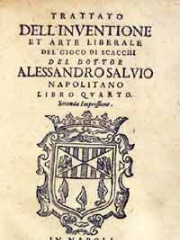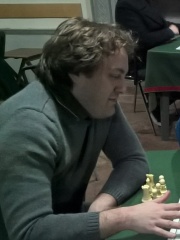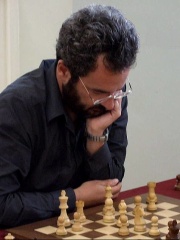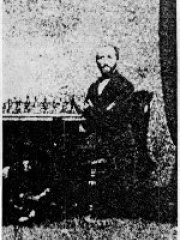






The Most Famous
CHESS PLAYERS from Italy
This page contains a list of the greatest Italian Chess Players. The pantheon dataset contains 461 Chess Players, 8 of which were born in Italy. This makes Italy the birth place of the 17th most number of Chess Players behind France, and Czechia.
Top 8
The following people are considered by Pantheon to be the most legendary Italian Chess Players of all time. This list of famous Italian Chess Players is sorted by HPI (Historical Popularity Index), a metric that aggregates information on a biography's online popularity.

1. Giovanni Leonardo Di Bona (1542 - 1597)
With an HPI of 64.28, Giovanni Leonardo Di Bona is the most famous Italian Chess Player. His biography has been translated into 23 different languages on wikipedia.
Giovanni Leonardo di Bona or Giovanni Leonardo da Cutro (both given names can also be seen in the reversed order Leonardo Giovanni), known as Il Puttino (Italian: Small Child) (1533–1578), was an early Italian chess master. Giovanni Leonardo was born in Cutro, Calabria. He studied law in Rome. In 1560, he lost a match to Ruy López in Rome. In the years 1566–1572, he traveled and played chess in Rome, Genoa, Marseille, and Barcelona. He had played many times against Paolo Boi in Italy, and they were regarded as being equal in strength. Traveling with another strong player of his time, Guilio Cesare Polerio, Leonardo won the first known international master tournament in Madrid in 1575, becoming the strongest chess master of the time. After their success at the Court of Spain, Leonardo and Boi both travelled, albeit separately, to Lisbon, where they tested their skill against Il Moro, the eminent chess champion of King Don Sebastian, of Portugal. Again, they both succeeded—first Leonardo, soon followed by Boi—in defeating Il Moro. After defeating López in Spain, he asked for his town Cutro to be forgiven of taxes and called Cutro the "City of Chess," where every year, this event is remembered on a traditional day in August. And again, the King was generous with his rewards. After this triumph, Leonardo, having been called the wandering knight (Il Cavaliere errante) by King Don Sebastian, left Portugal to return to Italy and settle in Naples, where he became the chess master for the Prince of Bisignano. Although only a small number of his games have reached us, we are certain that he did not play chess like his peers, who were all aggressive attackers. Instead, he was a slow, positional player who consistently favored sound tactics over spectacular combinations.

2. Gioachino Greco (1590 - 1630)
With an HPI of 63.73, Gioachino Greco is the 2nd most famous Italian Chess Player. His biography has been translated into 28 different languages.
Gioachino Greco (c. 1600 – c. 1634), surnamed Cusentino and more frequently il Calabrese, was an Italian chess player and writer. He recorded some of the earliest chess games known in their entirety. His games, which never indicated players, were quite possibly constructs, but served as examples of brilliant combinations. Greco was very likely the strongest player of his time, having played (and defeated) the best players of Rome, Paris, London, and Madrid. Greco's writing was in the form of manuscripts for his patrons, in which he outlined the rules of chess, gave playing advice, and presented instructive games. These manuscripts were later published to a wide audience and became massively influential after his death.

3. Alessandro Salvio (1570 - 1640)
With an HPI of 62.15, Alessandro Salvio is the 3rd most famous Italian Chess Player. His biography has been translated into 24 different languages.
Alessandro Salvio (c. 1575 – c. 1640) was a leading Italian chess player in the early 17th century. He started a chess academy in Naples, and wrote a book called Trattato dell'Inventione et Arte Liberale del Gioco Degli Scacchi, which was published in Naples in 1604. He also wrote Il Puttino published in 1634. According to JH Saratt's translation, Il Puttino was first published in 1604, and republished in 1634.

4. Giambattista Lolli (1698 - 1769)
With an HPI of 54.41, Giambattista Lolli is the 4th most famous Italian Chess Player. His biography has been translated into 16 different languages.
Giambattista Lolli (1698 – 4 June 1769) was an Italian chess player and one of the most important chess theoreticians of his time. He is most famous for his book Osservazioni teorico-pratiche sopra il giuoco degli scacchi (English: Theoretical-practical views on the game of chess), published 1763 in Bologna. Born in Nonantola, Modena, he was one of the Modenese Masters. The checkmate pattern "Lolli's mate" involves infiltrating an opponent's fianchetto position using both a pawn and queen, and is named after Giambattista Lolli.

5. Serafino Dubois (1817 - 1899)
With an HPI of 54.22, Serafino Dubois is the 5th most famous Italian Chess Player. His biography has been translated into 15 different languages.
Serafino Dubois (10 October 1817 – 15 January 1899) was an Italian chess Master and chess writer. Dubois was certainly among the strongest players in the world during the 1850s. He was known for his writings on the game, and for his promotion of chess in Italy.

6. Clarice Benini (1905 - 1976)
With an HPI of 53.54, Clarice Benini is the 6th most famous Italian Chess Player. Her biography has been translated into 16 different languages.
Clarice Benini (8 January 1905 – 6 September 1976) was an Italian chess player. She was awarded the title International Woman Master by FIDE in 1950. Benini was born in Florence. In 1936, she finished second, behind Sonja Graf, in Semmering, Austria. The next year, Benini also came second in the Women's World Championship at Stockholm, behind Vera Menchik and ahead of Sonja Graf, Milda Lauberte, Mary Bain, Mona May Karff, and others. She was the twice Italian women's champion, winning at Milan 1938 and Rome 1939. Benini took ninth place in the 1949/50 Women's World Championship in Moscow, which was won by Ludmila Rudenko. She tied for 3rd-4th at Venice 1951 (Women's World Championship zonal), won at Gardone 1956, took 6th at Venice 1957 (zonal), won at Amsterdam 1957, and took 2nd at Beverwijk 1958. On 6 September 1976, Benini was murdered by her neighbour, an insane farmer, in Poggio a Vico, Rufina, Florence.

7. Eros Riccio (b. 1977)
With an HPI of 48.40, Eros Riccio is the 7th most famous Italian Chess Player. His biography has been translated into 30 different languages.
Eros Riccio (born December 1, 1977, in Lucca) is an Italian International Correspondence Chess Grandmaster, Advanced Chess Champion and chess opening book author. He is FICGS World Champion and ICCF vice-European Champion and Olympic bronze with the Italian national team.

8. Alberto David (b. 1970)
With an HPI of 45.31, Alberto David is the 8th most famous Italian Chess Player. His biography has been translated into 16 different languages.
Alberto David (born 26 March 1970) is a Luxembourgish-Italian chess grandmaster. He is a three-time Italian Chess Champion.
People
Pantheon has 8 people classified as Italian chess players born between 1542 and 1977. Of these 8, 2 (25.00%) of them are still alive today. The most famous living Italian chess players include Eros Riccio, and Alberto David. The most famous deceased Italian chess players include Giovanni Leonardo Di Bona, Gioachino Greco, and Alessandro Salvio.
Living Italian Chess Players
Go to all RankingsDeceased Italian Chess Players
Go to all RankingsGiovanni Leonardo Di Bona
1542 - 1597
HPI: 64.28
Gioachino Greco
1590 - 1630
HPI: 63.73
Alessandro Salvio
1570 - 1640
HPI: 62.15
Giambattista Lolli
1698 - 1769
HPI: 54.41
Serafino Dubois
1817 - 1899
HPI: 54.22
Clarice Benini
1905 - 1976
HPI: 53.54

